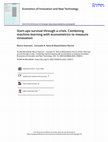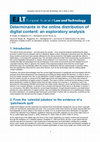Papers by Massimiliano Nuccio

Economics of Innovation and New Technology, 2020
This paper shows how data science can contribute to improving empirical research in economics by ... more This paper shows how data science can contribute to improving empirical research in economics by leveraging on large datasets and extracting information otherwise unsuitable for a traditional econometric approach. As a test-bed for our framework, machine learning algorithms allow to create a new holistic measure of innovation following a 2012 Italian Law aimed at boosting new hightech firms. We adopt this measure to analyse the impact of innovativeness on a large population of Italian firms which entered the market at the beginning of the 2008 global crisis. The methodological contribution is organised in different steps. First, we train seven supervised learning algorithms to recognise innovative firms on 2013 firmographics data and select a combination of those models with the best prediction power. Second, we apply the latter on the 2008 dataset and predict which firms would have been labelled as innovative according to the definition of the 2012 law. Finally, we adopt this new indicator as the regressor in a survival model to explain firms' ability to remain in the market after 2008. The results suggest that innovative firms are more likely to survive than the rest of the sample, but the survival premium is likely to depend on location.

Industrial and Corporate Change
Knowledge is largely recognized as a key driver of survival and growth of new entrants. Previous ... more Knowledge is largely recognized as a key driver of survival and growth of new entrants. Previous literature on the role of pre-entry knowledge in post-entry performance has focused on entrepreneurial and managerial capabilities and education and on knowledge incorporated in material and immaterial resources. In this paper, taking to the firm level the intuition behind the notion of economic and technological complexity of countries, we hypothesize that post-entry performance of new firms may be explained by their knowledge base complexity, which captures the reinforcing mechanism between variety and creation of new valuable knowledge. We provide a measure of firm-level complexity derived from the analysis of textual content of patents and exploit it to examine the empirical relation between pre-entry complexity of knowledge and post-entry growth in a sample of Italian firms entering the market in 2009-2011. Baseline results show a significant and positive association between knowled...

ABSTRACT Investment in culture and, in particular, the creation of cultural districts have genera... more ABSTRACT Investment in culture and, in particular, the creation of cultural districts have generated ambiguous effects in urban areas, especially whereas the focus on the so-called creative classes has been higher than the attention given to other professional and social groups. We hereby would like to show the effects of these policies in peripheral and disadvantaged contexts. Arguing on the localization of cultural activities as a mean to generate economic capital, we deem that the link culture-capital is not direct, but indirect. The process of "sociability building" triggered by common cultural experiences enhances cohesion. The paper argues that forms of art, which are usually considered “minor” or “marginal” in the cultural production, are able to activate processes of construction and reconstruction of the so-called "social" value, acting as relational goods and, therefore, source of social innovation. The argument for these effects is discussed on the basis of different case studies placed in three peripheral Italian territories (the island of Sardinia, Naples suburbia, Bolognese Appennines). We show that not-institutionalized performing arts have effectively addressed social issues by enabling relational power in the local communities.

Literature on online piracy has focused mainly on the legal framework necessary to prevent and pu... more Literature on online piracy has focused mainly on the legal framework necessary to prevent and punish copyright infringements on both the demand and supply sides. More recently, marketing and psychology studies have tried to understand the behavioral and ethical aspects connected with the consumption of pirated digital goods but little attention has been dedicated to the evolution in the distribution of digital content. This paper will analyze digital business models, isolate the main forms of digital distribution and evaluate the degree of hybridization that these businesses have accomplished in the move away from the traditional brick-and-mortar model. The article presents the results of an empirical study of 597 websites which distribute digital media content. For each website, data have been collected on a range of features including the distribution methods, the technical restrictions imposed on content, the copyright management and licensing systems, and the revenue models ado...

Questo volume presenta i risultati di un'indagine empirica multidisciplinare sui fattori ... more Questo volume presenta i risultati di un'indagine empirica multidisciplinare sui fattori di crescita e di competitività delle imprese vicentine, sviluppata attraverso le chiavi di lettura della macro e della microeconomia, della strategia e della finanza aziendale. La ricerca ha riguardato oltre duemila aziende manifatturiere studiate lungo un periodo di cinque anni, con l'obiettivo di individuare i sentieri di crescita quantitativa perseguiti dalle imprese locali e di indagare quali tra di esse hanno abbinato alla crescita dimensionale uno sviluppo qualitativo interno dell'organizzazione aziendale. L'analisi condotta offre uno sguardo sul futuro del sistema locale: un futuro in cui entrano in scena nuovi paradigmi aziendali, che scardinano i luoghi comuni dei settori maturi e delle dimensioni ottimali, lasciando invece spazio alla "sostenibilità competitiva", intesa come la capacità delle imprese di affrontare la competizione e di reagire in modo tempestivo ai continui cambiamenti del mercato. Il volume costituisce la premessa per più ampie riflessioni sulla capacità di tenuta e di reazione del sistema produttivo locale, in un momento di trasformazioni profonde e repentine che minacciano nelle fondamenta la capacità di competere delle imprese, nonché di interi distretti e territori industriali.

arXiv: General Economics, 2019
This paper shows how data science can contribute to improving empirical research in economics by ... more This paper shows how data science can contribute to improving empirical research in economics by leveraging on large datasets and extracting information otherwise unsuitable for a traditional econometric approach. As a test-bed for our framework, machine learning algorithms allow us to create a new holistic measure of innovation built on a 2012 Italian Law aimed at boosting new high-tech firms. We adopt this measure to analyse the impact of innovativeness on a large population of Italian firms which entered the market at the beginning of the 2008 global crisis. The methodological contribution is organised in different steps. First, we train seven supervised learning algorithms to recognise innovative firms on 2013 firmographics data and select a combination of those with best predicting power. Second, we apply the former on the 2008 dataset and predict which firms would have been labelled as innovative according to the definition of the law. Finally, we adopt this new indicator as r...

Eur. J. Law Technol., 2012
The article discusses the results of an empirical study on about 600 websites which distribute di... more The article discusses the results of an empirical study on about 600 websites which distribute digital media content. For each website, data has been collected on a range of features including the distribution methods, the technical restrictions imposed on content, the right management and licensing systems and the revenue models adopted. Using a 'bottom-up' clusterization technique, the data collected reveal unexpected characteristics of the current landscape for online distribution of digital contents. While it is commonly assumed that the current legislative framework tends to incentivise a system based on strong legal and technological control over the contents, the cluster analysis shows that online distribution has evolved into four main models. Moreover, it reveals that legal factors are not the most relevant ones in shaping a landscape which is mostly determined by technology.
SpringerBriefs in Business
Embedding tools are defined in this case as the instruments and systems to share content on socia... more Embedding tools are defined in this case as the instruments and systems to share content on social networks or other websites (e.g. embedding codes, widgets, etc.); in this text they will also be named as "sharing tools".
La complessita strutturale dei distretti industriali: un approccio basato sulle similarita multi-... more La complessita strutturale dei distretti industriali: un approccio basato sulle similarita multi-dimensionali Structural complexity in industrial districts: a multi-dimensional similarity approach. This study analyses spatial agglomerations starting from the premise that their intrinsic socio-economic complexity is a crucial factor in the shaping of local development paths. With the help of a family of artificial neural networks known as Self-organising Maps (SOM), the study obtains an original mapping of productive agglomerations in Italy, and thereby a characterization that goes beyond the notion of specialization and rests on the idea of multi-dimensional similarity in the distribution of resources.
Department of Management, Università Ca'Foscari Venezia Working Paper, 2020
Recent literature on the diffusion of robots mostly ignores the regional dimension. The contribut... more Recent literature on the diffusion of robots mostly ignores the regional dimension. The contribution of this paper at the debate on Industry 4.0 is twofold. First, IFR (2017) data on acquisitions of industrial robots in the five largest European economies are rescaled at regional levels to draw a first picture of winners and losers in the European race for advanced manufacturing. Second, using an unsupervised machine learning approach to classify regions based on their composition of industries. The paper provides novel evidence of the relationship between industry mix and the regional capability of adopting robots in the industrial processes.
Page 1. Pubblico, professioni e luoghi della cultura Un marketing per la cultura a cura di Fabio ... more Page 1. Pubblico, professioni e luoghi della cultura Un marketing per la cultura a cura di Fabio Severino Alessandro Bollo, Antonio Lampis, Paolo Leon, Giovanna Marinelli con Carla Sacco e Paola Scuderoni, Marco Meneguzzo con Mariastefania Senese, Mario Morcellini ...
European Planning Studies, 2021
Digital transformation has deeply influenced how innovation can rise in the production, distribut... more Digital transformation has deeply influenced how innovation can rise in the production, distribution and consumption of cultural products. Although data-driven innovation has been proved effective ...
Journal of Economics Methdology, 2018
The paper presents the topic modeling technique known as Latent Dirichlet Allocation (LDA), a for... more The paper presents the topic modeling technique known as Latent Dirichlet Allocation (LDA), a form of text-mining aiming at discovering the hidden (latent) thematic structure in large archives of documents. By applying LDA to the full text of the economics articles stored in the JSTOR database, we show how to construct a map of the discipline over time, and illustrate the potentialities of the technique for the study of the shifting structure of economics in a time of (possible) fragmentation

Competition and Change, 2019
The technology underlying the digital transformation triggered a process of concentration in seve... more The technology underlying the digital transformation triggered a process of concentration in several digital markets and few global players rose to dominate key industries by leveraging on network externalities and economies of scale.
We evaluate the risk of abuse of dominant position by looking at three economic aspects stressed in the economic theory: the contestability of digital markets, the presence of price discrimination, and potential for technological improvement. All in all, we conclude that the nature of big data on the one side has been the trigger of market concentration, but, on the other side, it limits the possibility of its abuse. This claim is not an a-priori apologia of large incumbents in digital markets, which should anyway kept under surveillance by antritrust authorities as any other industry, but rather an attempt to argue that market concentration is a matter a fact and not an necessarily evil one. Nonetheless, the concentration of power in few large global players should rise other concerns linked with the supranational nature of these firms, which can easily cherry-picking locations to exploit tax competition among countries or more favorable legislation on the privacy and the fair use of data.











Uploads
Papers by Massimiliano Nuccio
We evaluate the risk of abuse of dominant position by looking at three economic aspects stressed in the economic theory: the contestability of digital markets, the presence of price discrimination, and potential for technological improvement. All in all, we conclude that the nature of big data on the one side has been the trigger of market concentration, but, on the other side, it limits the possibility of its abuse. This claim is not an a-priori apologia of large incumbents in digital markets, which should anyway kept under surveillance by antritrust authorities as any other industry, but rather an attempt to argue that market concentration is a matter a fact and not an necessarily evil one. Nonetheless, the concentration of power in few large global players should rise other concerns linked with the supranational nature of these firms, which can easily cherry-picking locations to exploit tax competition among countries or more favorable legislation on the privacy and the fair use of data.
We evaluate the risk of abuse of dominant position by looking at three economic aspects stressed in the economic theory: the contestability of digital markets, the presence of price discrimination, and potential for technological improvement. All in all, we conclude that the nature of big data on the one side has been the trigger of market concentration, but, on the other side, it limits the possibility of its abuse. This claim is not an a-priori apologia of large incumbents in digital markets, which should anyway kept under surveillance by antritrust authorities as any other industry, but rather an attempt to argue that market concentration is a matter a fact and not an necessarily evil one. Nonetheless, the concentration of power in few large global players should rise other concerns linked with the supranational nature of these firms, which can easily cherry-picking locations to exploit tax competition among countries or more favorable legislation on the privacy and the fair use of data.
The paper refers to the case of MITO, a music festival launched in 2007 and based in Milan. Since the first edition, the festival has been observed in order to evaluate its capacity to produce positive effects in terms of cultural, social, and economic changes. A relevant amount of data concerning the audience and the cultural behaviour of the people attending the events has been collected. During the third edition, the analysis focused mainly on the economic effects generated by the event on the city of Milan. The case of MITO and the result of the analysis were compared with a panel of other national and international case studies. Data was used for an evaluation of the event itself, while the benchmark was used for a complementary investigation of the value of the cultural project studying different factors than those considered by the impact analysis.
fenomeno strettamente dipendente dalla specializzazione settoriale. Il presente studio ha
indagato le agglomerazioni spaziali di attività economiche, partendo dal presupposto della
loro intrinseca complessità socio-economica, che rende talvolta unici i percorsi dello sviluppo
locale. Al fine di rilevare la multi-dimensionalità di suddetti fenomeni e quindi di cogliere
somiglianze e differenze che tengano presente in modo simultaneo di diverse variabili, gli
autori hanno scelto di utilizzare strumenti analitici non-lineari. Questo ha permesso una
mappatura originale delle agglomerazioni produttive sul territorio italiano e una loro
caratterizzazione che supera il concetto di specializzazione e si basa sull’idea di similarità
multi-dimensionale nella distribuzione delle risorse impiegate. Il modello suggerisce che
l’integrazione strutturale dell’economia e della società a livello configuri forme originali di
vantaggi competitivi non riconducibili alle tradizionali filiere produttive."
È noto come lo studio e la conoscenza delle caratteritiche dei paesaggi storici, nell'accezione più ampia del termine, rappresentino i presupposti essenziali per garantire la salvaguardia del territorio e per la sua valorizzazione. Si tratta anche delle basi ineludibili per cercare di coniugare lo sviluppo culturale e sociale con quallo economico, garantito da una fruizione turistica sostenibile, improntata al rispetto dei valori materiali ed immateriali rappresentati dal patrimonio storico, artistico, etnoantropologico, archeologico e ambientale.
di rigenerazione urbana sono oggetto di studio multidisciplinare da parte
di diversi studiosi, tra cui pianificatori, geografi, economisti e sociologi. A
partire dagli anni 2000, una questione che emerge dal confronto tra le varie
discipline è quella della città creativa, in cui le arti e le industrie culturali si
diffondono come attività trainanti, influenzano le modalità di produzione e
il consumo degli individui, e modificano le forme e l’uso degli spazi costruiti.
Rigenerazione urbana e città creativa sono spesso affrontate in modo congiunto,
senza argomentare in modo univoco cause ed effetti, interdipendenze
reciproche, concentrandosi forse in modo eccessivo sul concetto piuttosto
vago di classe creativa. Questo capitolo affronterà in modo sintetico quattro
temi ricorrenti ma tutt’altro che risolti nelle politiche urbane e culturali: formazione
di distretti culturali, costruzione di edifici iconici, moltiplicazione
di eventi e festival, e interventi di arte pubblica. Molte città in tutto il mondo
hanno investito su uno o più di questi piani con risultati talvolta contradditori.
Si presentano di seguito le criticità emerse più chiaramente dalla implementazione
di tali strategie.